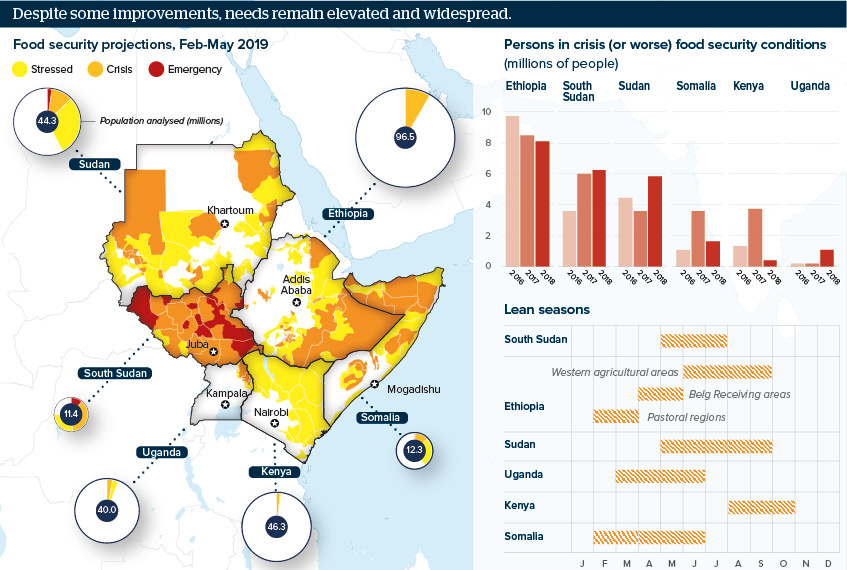Vulnerability deepens East African food crisis risks
Increasingly frequent droughts combine with conflict and market disruptions to heighten the risk of regional food crises
Source: FEWSNET; IPCINFO; UNOCHA; AfDB
Outlook
After recurrent droughts from 2015-17, improved rains in mid-2018 looked to be easing regional food insecurity. However, new warnings of poor rains are renewing concern as the region’s ‘lean seasons’ approach.
Drought is but one factor underlying regional food insecurity; conflict is the leading driver, while market disruptions can make food unattainable even when available. Vulnerability exacerbates risk: many populations face persistent food gaps even in good years; those reliant on subsistence agriculture or pastoralism are especially vulnerable to sudden shocks.
The African Development Bank warns that drought risk has risen from once every 6-8 years to once every 2-3 years, leaving communities with little time to recover.
Impacts
- In most areas, climate, conflict and economic stresses will work in combination to undermine food security.
- Despite a peace deal, South Sudan faces an ongoing famine risk as livelihoods, markets and humanitarian assistance remain disrupted.
- Despite improved rains in Ethiopia, massive new displacements due to rising ethnic conflict mean needs will remain elevated.
- Rampant inflation and spiralling food prices is deepening food insecurity in Sudan despite improving security and rainfall.
See also
- Major drought may drive new East Africa hunger crisis - Feb 1, 2022
- COVID-19 may disrupt Africa’s food security - Mar 31, 2020
- Locusts threaten fragile East Africa food security - Feb 6, 2020
- East Africa locusts pose major food security threat - Jan 21, 2020
- Prospects for East Africa and the Great Lakes in 2020 - Nov 20, 2019
- East Africa floods will exacerbate fragility - Oct 29, 2019
- Somalia may face chronic hunger issue - Sep 10, 2019
- Global climate policy will focus on land use - Aug 29, 2019
- Constraints will undermine Kenya’s ‘Big Four’ agenda - Aug 15, 2019
- Rising emissions worsen global disaster risks - Jun 12, 2019
- East Africa food security will test resilience concept - Aug 16, 2017
- More graphic analysis
